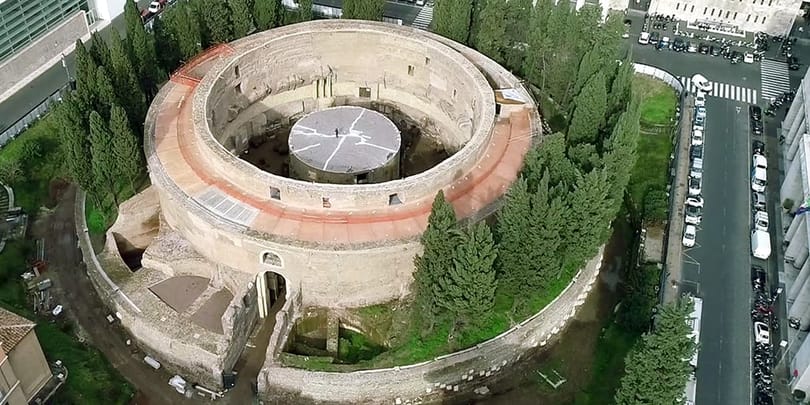The Mausoleum of Augustus in Rome reopens after 14 years of restoration work. “From March 1, the day of the reopening, until April 21, the Christmas of Rome (anniversary of the foundation of Rome), visits will be free for everyone,” said the Mayor, Virginia Raggi, “and for the whole of 2021 it will be free for the Romans.
“It is a gift I give to my fellow citizens.
“I invite everyone to book. From December 21, the booking site will be open in order to comply with COVID regulations.
“The path to get here was long. From the planning stages to the actual restoration work up to the museum projects that Fondazione Tim is doing. It’s a job of a team that has gone forward over the years to return this monument to the Romans and to the whole world.”

A message of hope
The Mausoleum of Augustus, also known as Augusteo, is an imposing funerary monument of the first century BC with a circular plan located in Piazza Augusto Imperatore in Rome. It originally occupied part of the northern area of the Campo Marzio.
It was started by Augustus in 28 BC on his return from Alexandria after conquering Egypt and defeating Marcus Antony.
It was during his visit to Alexandria (Egypt) that he had the opportunity to see the Hellenistic-style tomb of Alexander the Great, probably with a circular plan, from which he drew inspiration for the construction of his own mausoleum.
The monument, devastated by centuries of looting and removal of materials and definitively freed from excavations only in 1936, with its diameter of 300 Roman feet (about 87 meters), is the largest circular sepulchre known.
“Among the monuments of Campo Marzio,” wrote Strabo, “the most beautiful is the Mausoleum, which is a mass of white stones located near the river on a high substructure and surrounded by green trees which rise up to its top; then on the top, the metal statue of Caesar Augustus. Today facing by the Ara Pacis inside the mass is his niche with those of his blood relatives and his servants.”
The Mausoleum of Augustus is a funerary monument of the emperor Octavian Augustus, begun by his will in 29 BC, when he had not yet become emperor, on his return from Alexandria, after having conquered Egypt and defeated Marcus Antony in the battle of Actium of 31 BC.
Augustus was inspired by the Hellenistic-style tomb of Alexander the Great, which he had visited in Alexandria, also with a circular plan, as well as the Mausoleum of Halicarnassus, built around 350 BC. in honor of King Mausolus, but also to the Etruscan tombs.
Originally it occupied part of the northern area of called Campo Marzio. This district was embellished by many monuments in the Republican age, but with Augustus it experienced a total renewal, especially in the central area and the northern one: the Theatre of Marcellus, the Baths of Agrippa, the Pantheon, the Saepta, the Ara Pacis, and the Mausoleum.
It is not known if Vespasian and Claudius were buried here. Caligula laid the ashes of his mother Agrippina and of the brothers Nerone Cesare and Druso Cesare; later the remains of her other sister, Giulia Livilla, were brought there.
Nero, as previously the daughter of Augustus, Julia the Major, was excluded as she was from the dynastic tomb for unworthiness.
The last to be buried inside the Mausoleum was Nerva in 98 AD. His successor, Trajan, was in fact cremated, and his ashes were placed in a gold urn at the foot of the Trajan’s Column.
In fact, the tomb was the first to house the remains of Marco Claudio Marcello, the grandson of Augustus who died in 23 BC, whose inscription on a marble slab discovered in 1927, together with Augustus’s mother, Azia minor, whose inscription is reported on the same marble by Claudio Marcello.
Then followed Marco Vipsanio Agrippa, Octavian’s inseparable friend, then Drusus major, Lucius, and Gaius Caesar. Augustus was buried in 14, followed by Drusus minor, Germanicus, Livia, and Tiberius.
It is not known if they were buried here with Vespasian and Claudius. Caligula laid the ashes of his mother Agrippina and of the brothers Nerone Cesare and Druso Cesare; later the remains of the other sister, Giulia Livilla, they brought there.
The decadence
In the 10th century, the building was transformed into a fortress by the Roman Colonna family. In 1354, the body of Cola di Rienzo was burned there. In the 16th century, the tomb became an ornamental garden. Finally, in the 17th century, a wooden amphitheatre was built all around, transforming it into an arena for bullfights.
The visits, lasting about 50 minutes, will take place from Tuesday to Sunday from 9 am to 4 pm (last admission at 3 pm). They will be completely free for everyone until April 21, 2021 with reservations required on the mausoleodiaugusto.it ويب سائيٽ.
#بحالي سفر
هن آرٽيڪل مان ڇا وٺو:
- The Mausoleum of Augustus is a funerary monument of the emperor Octavian Augustus, begun by his will in 29 BC, when he had not yet become emperor, on his return from Alexandria, after having conquered Egypt and defeated Marcus Antony in the battle of Actium of 31 BC.
- In fact, the tomb was the first to house the remains of Marco Claudio Marcello, the grandson of Augustus who died in 23 BC, whose inscription on a marble slab discovered in 1927, together with Augustus’s mother, Azia minor, whose inscription is reported on the same marble by Claudio Marcello.
- It was during his visit to Alexandria (Egypt) that he had the opportunity to see the Hellenistic-style tomb of Alexander the Great, probably with a circular plan, from which he drew inspiration for the construction of his own mausoleum.























